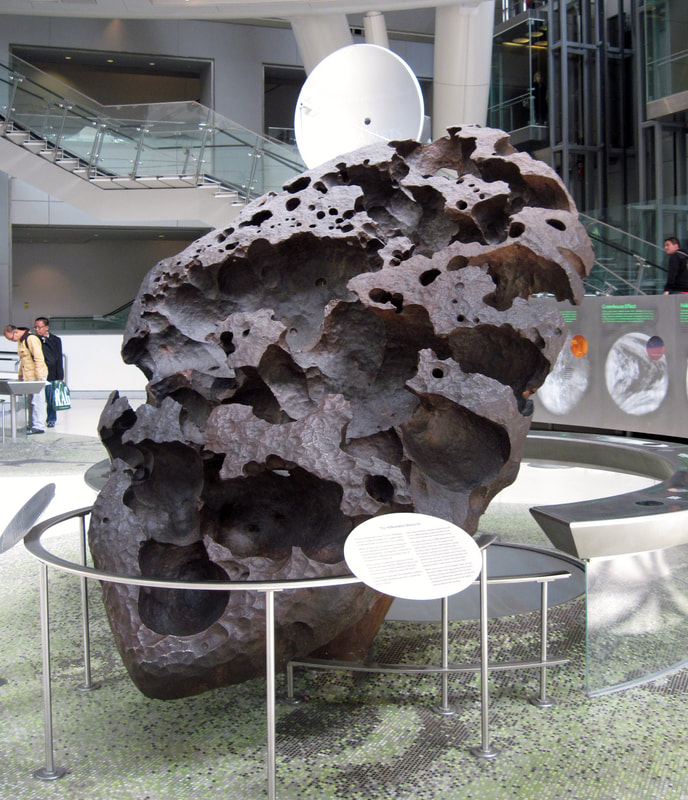Visitor From Heaven:
The story of the much loved - and much contested - “Willamette Meteorite”
Those who reside in West Linn know the town for its peaceful neighborhoods, good schools and beautiful surroundings. But this little suburb was the site of an incredible astronomical event, one that had profound significance for the original inhabitants of the region and helped define our place in the universe. Throw in an old-fashioned Wild West heist and you’ve got an amazing story!
At the birth of our solar system, interstellar clouds formed, and within those clouds our sun formed 4.5 billion years ago. The same mechanisms that created the sun also led to the formation of comets, asteroids, planets and all life on Earth. Billions of years ago, a planet orbiting the sun was likely shattered by a collision with another celestial body. Eventually a large fragment of that broken planet hurtled toward Earth at more than 64,000 kilometers an hour and crashed down in what is now Canada. Then, 17,000 years ago, the Missoula floods picked up that meteorite and set it down in the Willamette Valley. The massive size of this meteor — the largest found in the United States and the sixth largest in the world — as well as its iron composition make it an incredible souvenir of the foundations of the universe. Only about 600 of the 25,000 meteorites found on Earth are made of iron, which is created deep inside stars. Studying the “Willamette Meteorite” is also a study of our chemical origins.
Before Europeans even arrived in the area, the Clackamas tribe inhabited the region. They discovered the giant object and believed it to be sacred, a sign from the revered Sky People. They named it Tomanowos. According to their traditional teachings, when the meteorite came to earth, a union was formed between the sky, earth and water. The craters of the meteorite held rainwater, and this water was considered a powerful purifying, cleansing and healing source for the Clackamas and neighboring tribes. Tribal hunters dipped their arrows in the water, believing it granted them strength.
In 1902, the Clackamas people were removed to the Grand Ronde Reservation and white homesteader Ellis Hughes “discovered” the meteorite near his land. Recognizing the significance of the object, he spent three months on a covert relocation project, eventually moving Tomanowos three-quarters of a mile to his property. Secretly moving the 16-ton meteorite with a wooden wagon was no easy feat. But once Ellis accomplished this, he started charging admission to visitors to view the “Willamette Meteorite.” It wasn’t long before the Oregon Iron and Steel Company, which owned the land where Tomanowos originally settled, discovered the theft. The company sued Ellis for its return. While the case was in litigation, an armed guard kept a 24-hour post on the meteorite. The company won the case and after “Willamette” was returned. In 1905, a private citizen purchased it for $26,000 (over $800,000 in 2021 dollars) and donated it the American Museum of Natural History in New York where it remains on display to this day.
The fight for ownership, however, didn’t stop when it was removed from Ellis Hughes’ property. The Confederated Tribes of Grand Ronde had used Tomanowos in ceremonies throughout their history and demanded its return in 1999. The museum filed a federal lawsuit against Grand Ronde in 2000 to keep the meteorite but later that year they reached an agreement allowing tribal members to hold an annual private ceremony with Tomanowos. The agreement also stipulated that ownership will be returned to the tribe if and when the museum no longer displays it. In 2019 several fragments of the meteorite that had been held separately were returned to the tribe.
Sarah Horner is a freelance writer, photographer and Oregon wine industry professional. She and her husband are empty nesters who live with three cats on a small orchard in Amity, OR.
Photo by: www.flickr.com-photos-48082563@N08_willamette meteorite
At the birth of our solar system, interstellar clouds formed, and within those clouds our sun formed 4.5 billion years ago. The same mechanisms that created the sun also led to the formation of comets, asteroids, planets and all life on Earth. Billions of years ago, a planet orbiting the sun was likely shattered by a collision with another celestial body. Eventually a large fragment of that broken planet hurtled toward Earth at more than 64,000 kilometers an hour and crashed down in what is now Canada. Then, 17,000 years ago, the Missoula floods picked up that meteorite and set it down in the Willamette Valley. The massive size of this meteor — the largest found in the United States and the sixth largest in the world — as well as its iron composition make it an incredible souvenir of the foundations of the universe. Only about 600 of the 25,000 meteorites found on Earth are made of iron, which is created deep inside stars. Studying the “Willamette Meteorite” is also a study of our chemical origins.
Before Europeans even arrived in the area, the Clackamas tribe inhabited the region. They discovered the giant object and believed it to be sacred, a sign from the revered Sky People. They named it Tomanowos. According to their traditional teachings, when the meteorite came to earth, a union was formed between the sky, earth and water. The craters of the meteorite held rainwater, and this water was considered a powerful purifying, cleansing and healing source for the Clackamas and neighboring tribes. Tribal hunters dipped their arrows in the water, believing it granted them strength.
In 1902, the Clackamas people were removed to the Grand Ronde Reservation and white homesteader Ellis Hughes “discovered” the meteorite near his land. Recognizing the significance of the object, he spent three months on a covert relocation project, eventually moving Tomanowos three-quarters of a mile to his property. Secretly moving the 16-ton meteorite with a wooden wagon was no easy feat. But once Ellis accomplished this, he started charging admission to visitors to view the “Willamette Meteorite.” It wasn’t long before the Oregon Iron and Steel Company, which owned the land where Tomanowos originally settled, discovered the theft. The company sued Ellis for its return. While the case was in litigation, an armed guard kept a 24-hour post on the meteorite. The company won the case and after “Willamette” was returned. In 1905, a private citizen purchased it for $26,000 (over $800,000 in 2021 dollars) and donated it the American Museum of Natural History in New York where it remains on display to this day.
The fight for ownership, however, didn’t stop when it was removed from Ellis Hughes’ property. The Confederated Tribes of Grand Ronde had used Tomanowos in ceremonies throughout their history and demanded its return in 1999. The museum filed a federal lawsuit against Grand Ronde in 2000 to keep the meteorite but later that year they reached an agreement allowing tribal members to hold an annual private ceremony with Tomanowos. The agreement also stipulated that ownership will be returned to the tribe if and when the museum no longer displays it. In 2019 several fragments of the meteorite that had been held separately were returned to the tribe.
Sarah Horner is a freelance writer, photographer and Oregon wine industry professional. She and her husband are empty nesters who live with three cats on a small orchard in Amity, OR.
Photo by: www.flickr.com-photos-48082563@N08_willamette meteorite
Copyright 2021. All rights reserved. Willamette Valley Life

